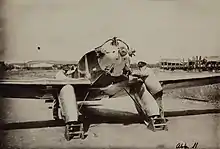| L 59 | |
|---|---|
 | |
| Role | Sport aircraft |
| Manufacturer | Albatros Flugzeugwerke |
| First flight | 1923 |
| Produced | 4 (both variants) |
The Albatros L 59 was a single-seat German utility aircraft of the 1920s. It was a single-engine low-wing cantilever monoplane with large, spatted wide track undercarriage attached, unusually for the time not to the fuselage but to the wing roots. The whole aircraft was covered in 3-ply.[1]
The L.59 was flying by September 1923.[1]
Variants
- L.59
- Single seat, 60 hp (45 kW) Siemens-Halske Sh.4 5-cylinder radial.[1] One built.[2]
- L.60
- Two seats, 80 hp (60 kW) Siemens-Halske Sh 5 7-cylinder radial. Identical dimensions, slightly heavier empty and faster both level and climbing.[1][3] Three built.[4]
Specifications (L 59)
Data from Flight 13 September 1923, pp. 581–2

L.59
General characteristics
- Crew: one pilot
- Length: 5.40 m (17 ft 9 in)
- Wingspan: 10.30 m (33 ft 9 in)
- Height: 2.65 m (8 ft 8 in)
- Wing area: 10.0 m2 (108 sq ft)
- Empty weight: 350 kg (772 lb)
- Gross weight: 485 kg (1,069 lb)
- Powerplant: 1 × Siemens-Halske Sh.4 5-cylinder radial , 45 kW (60 hp)
Performance
- Maximum speed: 140 km/h (90 mph, 78 kn) at 3,000 m (9,840 ft)
- Range: 525 km (327 mi, 284 nmi)
- Rate of climb: 1.9 m/s (365 ft/min) to 1,000 m (3,280 ft)
References
Wikimedia Commons has media related to Albatros L 59.
- 1 2 3 4 "The Albatros sporting types L.59 and L.60". Flight. Vol. XV, no. 37. 13 September 1923. pp. 581–2.
- ↑ "German Aircraft between 1919-1945 - Albatros L.59". Retrieved 9 August 2013.
- ↑ "The German exhibits". Flight. Vol. XV, no. 24. 12 June 1924. p. 384.
- ↑ "German Aircraft between 1919-1945 - Albatros L.60". Retrieved 9 August 2013.
- Taylor, Michael J. H. (1989). Jane's Encyclopedia of Aviation. London: Studio Editions. p. 55.
This article is issued from Wikipedia. The text is licensed under Creative Commons - Attribution - Sharealike. Additional terms may apply for the media files.